Plants and animals are easy to differentiate by their appearance and unique characteristics.
Plants are the only living entity that has the potential for photosynthesis. And thus they are the most precious pillar of the ecosystem. They use the naturally available raw stuff like water and carbon dioxide to prepare carbohydrates. For this reaction, the sunlight acts as an energy source that is trapped by chlorophyll.
In contrast, animals are devoid of photosynthetic ability. This is because they lack chlorophyll pigment. They rely on plants or other different organisms for nutrition.
We refer to plants as autotrophs due to their autotrophic mode of nutrition. And animals as heterotrophs because of the heterotrophic mode of nutrition.
In the following section, we will learn the primary differences between plants and animals.
Content: Plants Vs Animals
Comparison Chart
| Basis for Comparison | Plants | Animals |
|---|---|---|
| Meaning | Plants are green in colour due to the presence of the chlorophyll and are able to prepare their own food with the help of sunlight, water and air. They are known for providing oxygen to the atmosphere. | Animals are the living organisms which feed on the organic material and are known to have a specialized system in their body like the nervous system, reproductive system, sense organs, which make them unique from the other forms of life. |
| Movement | Plants do not have the ability to move from one place to another, as plants are rooted into the ground, exceptions are Volvox and Chlamydomonas. | Animals can move from one place to another freely, and exceptions are Sponges and Corals. |
| Mode of nutrition | Plants have chlorophyll, due to which they have the capability to prepare their own food and are known as autotrophs. | Animals are the heterotrophs, as they depend on plants for their food, either directly or indirectly. |
| Storage of food | Plants do not have the digestive system, and the storage of food (carbohydrate) takes place in the form of starch. | Animals have the proper digestive system which support the food in digesting and absorbing nutrition from it, the food (carbohydrate) is stored in the form of glycogen. |
| Respiration | Plants take in carbon dioxide and release oxygen into the atmosphere, exchange of gases occurs through stomata. | Animals take in oxygen and release carbon dioxide into the atmosphere, which occurs through lungs, gills, skin, etc. |
| Cellular structure | The cellular structure of plants contains the cell wall, chloroplast, plasmodesmata, plastids and other different organelles. | The cellular structure of animals does not have cell walls, though other organelles like the tight junction, cilia are present. |
| Growth | The growth of the plants takes place throughout the life, the meristematic system present in the tip of roots and stems supports the growth. | The organs and organ system supports the growth and is definite. |
| Reproduction | Reproduction of plants takes place asexually like by budding, vegetative methods, spores, wind, or through insects. | Some lower animals like algae reproduce asexually while higher animals reproduce sexually. |
| Response | Plants show the response to stimuli like touch, light, though are less sensitive due to the absence of the sense organs. | They have proper nervous system and response to any stimuli in a fraction of seconds, so they are regarded as highly sensitive. |
What are Plants?
Plants cover about 4.5 billion hectares of our earth’s surface. It is estimated that there are around 390,880 species of plants found till date, and there are more in counting.
We often refer to plants as autotrophs or producers of the environment. They are the most significant element in the running the proper functioning of the environment. This is due to their unique ability to synthesize food with naturally present inorganic matter.
The plants absorb the solar energy from the sun. And transform it into chemical energy with the process called photosynthesis. They are present at the start point of almost all kinds of chains for this exceptional quality.
The plants come under the kingdom Plantae. They are multicellular entities comprised of differential eukaryotic cells. Looking at their structure, they have a distinct root and shoot system.
Note: The study of plants is called botany. And those who study botany are called a botanist.
Cellular Characteristics of Plants
- Cell wall: The plants have a cell wall that is made from cellulose. It is the outermost covering of plant cells that make it firm and rigid.
- Plastids: These are the specialized organelles to store different pigments. The chloroplast that stores chlorophyll is also a plastid.
- Vacuoles: Cells of plants have gigantic vacuoles. Sometimes the vacuole covers more than half of the cell’s area.
- Centrosomes: The centrosomes are absent in the plant cells.
Physiological Characteristics of Plants
1. Nutrition
- The plants have an autotrophic mode of nutrition.
- They perform photosynthesis by using carbon dioxide and water in the presence of sunlight and chlorophyll.
2. Growth
- The growth of a plant is limited to the regions where the meristematic tissues lie. These tissues are generally located at the tips of the shoot and root or in the peripheral edges of the stem.
This means that the entire plant body cannot grow in size. - The growth of plants is not restricted with time. They can constantly grow until they ultimately die.
3. Respiration
- The plants exchange the gases for respiration through small pores called stomata.
- They intake carbon dioxide while they give out oxygen.
4. Movement
- The plants are fixed in the soil and cannot locomote from their places.
- Some plants like algae and some hydrophytes are exceptional that float over water.
5. Digestion
- They do not have the digestive system as they don’t require it.
- Since they make their own food, there is no case of digesting it.
6. Food Storage
- The plant stores the extra food, i.e., carbohydrates, in the form of starch.
- This food might be present in any plant part like roots, stem etc.
7. Excretion
- Plants secrete some harmless chemical compounds, which are generally produced as a by-product.
- Some common secretions include resins, latex, rubber, gum etc.
8. Reproduction
- They can reproduce via a sexual or asexual (vegetative) method.
- Depending upon the level of organization, the complexity of reproduction increases.
9. Responses
- The plant body lacks the responsive sense organs. Thus they deprive the fundamental skill to sense.
- In contrast, they respond to external stimuli like light and touch.
Types of Plants
There are five categories of plants: Herbs, shrubs, trees, creepers and climbers.
1. Herbs
These are the shortest plant with a small size and delicate appearance. They are so gentle that they might get uprooted easily with a sudden jerk or even fast winds. Herbs have a simple and short life cycle that completes in one or two seasons. Most of the herbs have high nutritional values with medicinal use.
Example: Rosemary, grass, coriander, mint etc.
2. Shrubs
These are mediocre sized plants that are more firm and rigid. Shrubs are larger than herbs, with a height lying between 6 to 10 meters. Most of the shrubs have a woody appearance having numerous branches. Their life span varies with the respective species.
Example: Basil, rose, hibiscus, lemon etc.
3. Trees
The trees are the largest, tallest and strongest types of plants. They have a rigid and thick structure with an enlarged body surface.
The main middle stem is hard and woody. It further splits into many big and small branches. Trees have the most complex structural organization among all the plants. Their life cycle is an elongated one that lasts for hundreds of years.
Example: Apple, mango, peepal, neem, banyan etc.
4. Climbers
These are delicate plants that are unable to stand on their own. Thus they need the support to grow and carry their weight. In order to grow vertically, they climb on the external support therefore, we refer to them as climbers.
Examples: Money plants, bitter guard, jasmine, peas etc.
5. Creepers
These are the most vulnerable plants that are fragile and slender stems. Alike climbers, they also cannot stand on their own. But they lack the ability to utilize the external support to stand and grow vertically. For this reason, they creep on the ground and grow horizontally. Thus, we refer to them as creepers.
Examples: watermelon, sweet potatoes, pumpkin etc.
Importance of Plants
The plants serve a very critical role of producer in any ecosystem. They provide the fundamental kickstart to a food chain. All the animals either directly or indirectly rely on the plants for their survival.
They fulfil the basic needs of oxygen, food and shelter to many animals. Plants also have great medicinal value. Altogether, they are the strong foundation over which the structure of the environment is constructed.
What are Animals?
The animals belong to the Animalia kingdom. Their level of organization varies greatly as per the type of species.
Our planet earth consists of several million different varieties of animals. They have a broad range of habitats, i.e., from aqueous to terrestrial.
The animals lack the ability to survive on their own. This is because they do not possess chlorophyll thus can’t make food with naturally available inorganic stuff. They have a heterotrophic mode of nutrition, and we refer to them as heterotrophs.
Their body is multicellular that comprise finely distinguishable eukaryotic cells. Different cells are assigned with various purposes needed for the optimal functioning of the animal body.
Cellular Characteristics of Animals
- Cell wall: The animal cell is devoid of cell walls. Thus, the outermost layer of an animal cell is the cell membrane.
- Plastids: These are absent in animal cells. Due to this, they lack the ability to photosynthesis.
- Vacuoles: The vacuoles are either very small or completely absent.
- Centrosomes: They are present in animal cells.
Physiological Characteristics of Animals
1. Nutrition
- They have a heterotrophic mode of nutrition.
- The animals depend either on plants or on other animals for sufficing their food requirement.
2. Growth
- An animal’s body grows from all directions, unlike plants. Their growth is not restricted to particular regions only. Instead, all the body parts and organs grow equally in animals.
- The growth of the animal body is paused with time at maturity.
3. Respiration
- The animals have well-defined respiratory mechanisms involving the nose, windpipe, lungs, bronchioles and alveoli.
- They intake oxygen while giving out carbon dioxide.
4. Movement
- Most of the animals can locomote.
- Lower animals might not possess specialized locomotory organs. But they move by actions like crawling, creeping, floating, summer salting etc.
5. Digestion
- Animal intake the plants or other animals as food. Thus, there is an intense need to extract energy from the taken food.
- For this reason, they have a sophisticated digestive tract.
- There are few exceptions, like lower animals and parasitic animals that lack the digestive system.
6. Food Storage
- The animals do not require to store a large amount of food.
- Only the extra carbohydrates are stored in the form of glycogen. The body uses this glycogen in case of additional demand for energy.
- Also, the adipose tissues that are present below the skin store fat.
7. Excretion
- The animals produce the waste materials like uric acid, ammonia, urea etc.
8. Reproduction
- The animals can reproduce sexually as well as asexually.
- Mainly the lower organisms reproduce asexually, and the higher ones can only reproduce sexually.
9. Responses
- They have a highly efficient nervous system that produces a response to the stimulus.
- Also, they bear sense organs for sensing smell, touch, sound, taste and vision.
Classification of Animals
Based on the vertebral column
On the basis of the presence or absence of vertebral column, we can classify the animals as:
1. Invertebrates: Around 97% of the total animal count are invertebrates. These are lower animals with less developed structural organization. They lack the vertebral column.
2. Vertebrates: They are higher animals with well-defined vertebrae. Their structural organization is more advanced than that of invertebrates.
Based on the blood type
1. Homeothermal: These are warm-blooded animals. They can maintain the body temperature irrespective of the external weather conditions.
2. Poikilothermal: Animals with cold blood are poikilothermic. They cannot maintain their body temperature. And thus, the temperature of their blood rises and fall with the change in environmental conditions.
Based on the Embryo Development
1. Oviparous: Those animals that lay an egg. All the embryonic development of the embryo occurs outside the mother’s body. And when the egg hatches, a developed offspring comes out.
2. Viviparous: Here, embryonic development takes place inside the mother’s womb. A completely developed organism comes out from the mother’s body. These are often referred to as mammals.
Importance of Animals
The animals are equally significant for balancing the environment and its components. They play the part of consumers, and thus, they aid the proper functioning of the food chain. Also, they provide stability to the environment.
Animals meet our needs for many products like leather, meat, milk, eggs etc.
Key Differences Between Plants and Animals
- The plants have the unique ability to photosynthesize their own food. But animals lack this mechanism and are dependent on plants or other animals for food.
- Due to the ability of photosynthesis the plants are autotrophic. And as the animals cannot perform photosynthesis they are heterotrophic in nature.
- Plants contain a large amount of chlorophyll that aids the process of photosynthesis. While animals don’t have chlorophyll at all.
- Animals have the ability to locomote from one place to another. But the plants are stationary bodies that remain fixed in the soil.
- For the storage of food, oils, excreta, etc. the plants bear large-sized vacuoles. Whereas, the vacuoles are either small or absent in animals.
- The plants intake carbon dioxide and release oxygen via a stomatal opening. While the animals intake oxygen and give out carbon dioxide through nostrils.
- The growth in plants is not halted with time and thus they keep on growing their entire life. In contrast, time and maturity pause the growth of an animal.
- Plants respond to stimuli like touch, light etc. and are less sensitive as they lack the sense organs. Animals have the proper nervous system and sense organs. Due to this, they respond to any stimuli in a fraction of seconds.
Similarities
- Both of them respond to stimuli.
- Being living entities both breathe, reproduce, grow.
- Plant and animals try to adapt according to changes in the environment.
- The basic unit of their structure is the eukaryotic cell.
- Air and water are the basic need for survival.
- They proper grow and develop.
Conclusion
In this context, we studied the ground points on which the plants differ from the animal. We can say that, after having a few characters similar, both plants and animals show a lot of variations. Another thing is that they both have a mutual relationship to maintain the ecosystem. So they are equally important and play a significant role in the environment.

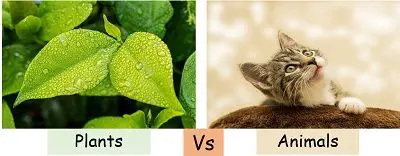



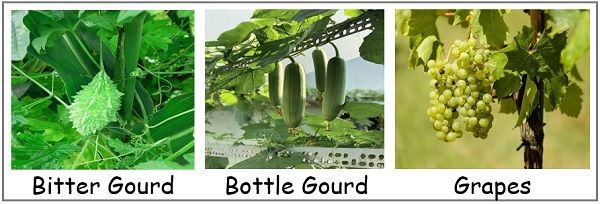
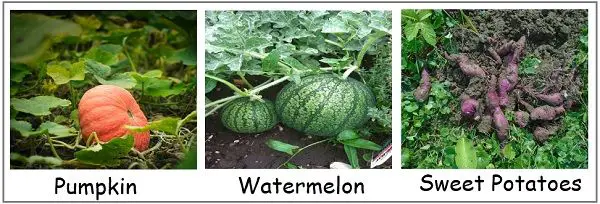
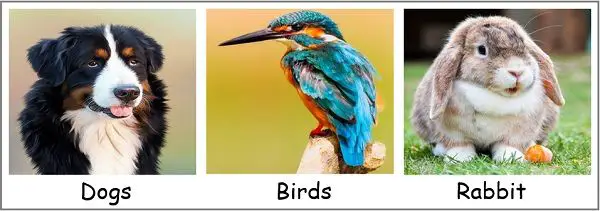
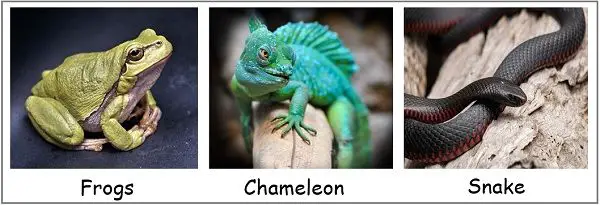


Junior L. Zoker says
Thanks a lot
hussnain ali says
very good work..
Haminat Ajoke says
This really helped
Thanks 👍
Safura says
Thanks alot am very grateful 👍👍
pv.Sarma says
Excellent information nicely presented
Thanks
Akiboyo Bola says
I Loved this article.